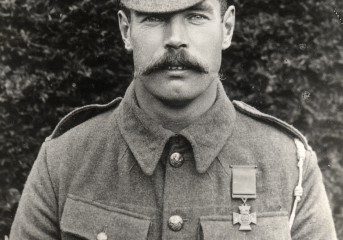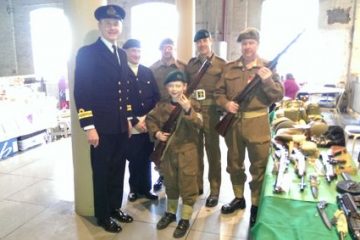THERE is a word you often see, pronounce it as you may
“You bike,” “you bykwee,” “ubbikwe “—alludin’ to R.A.
It serves ’Orse, Field, an’ Garrison as motto for a crest,
An’ when you’ve found out all it means I’ll tell you ’alf the rest.
Ubique means the long-range Krupp be’ind the low-range ’ill—
Ubique means you’ll pick it up an’, while you do, stand still.
Ubique means you’ve caught the flash an’ timed it by the sound.
Ubique means five gunners’ ’ash before you’ve loosed a round.
Ubique means Blue Fuse an’ make the ’ole to sink the trail.
Ubique means stand up an’ take the Mauser’s ’alf-mile ’ail.
Ubique means the crazy team not God nor man can ’old.
Ubique means that ’orse’s scream which turns your innards cold!
Ubique means “Bank, ’Olborn, Bank—a penny all the way—
The soothin’, jingle-bump-an’-clank from day to peaceful day.
Ubique means “They’ve caught De Wet, an’ now we sha’n t be long.”
Ubique means “I much regret, the beggar’s goin’ strong!”
Ubique means the tearin’ drift where, breech-blocks jammed with mud,
The khaki muzzles duck an’ lift across the khaki flood.
Ubique means the dancing plain that changes rocks to Boers.
Ubique means the mirage again an’ shellin’ all outdoors.
Ubique means “Entrain at once for Grootdefeatfontein”!
Ubique means “Off-load your guns”—at midnight in the rain!
Ubique means “More mounted men. Return all guns to store.”
Ubique means the R. A. M. R. Infantillery Corps!
Ubique means that warnin’ grunt the perished linesman knows,
When o’er ’is strung an’ sufferin’ front the shrapnel sprays ’is foes;
An’ as their firin’ dies away the ’usky whisper runs
From lips that ’ave n’t drunk all day: “The Guns! Thank Gawd, the Guns!”
Extreme, depressed, point-blank or short, end-first or any’ow,
From Colesberg Kop to Quagga’s Poort—from Ninety-Nine till now—
By what I’ve ’eard the others tell an’ I in spots ’ave seen,
There’s nothin’ this side ’Eaven or ’Ell Ubique does n’t mean!
[Title] The original Latin motto of the Royal Artillery was Quo Fas et Gloria ducunt (‘Where Right and Glory lead’), but in 1833, to reflect its role on every battlefield, King William IV ordered that it should bear the additional title of Ubique (‘Everywhere’) in place of all battle honours won by individual units. When the poem was collected for the Sussex Edition Kipling added the subscript ‘(Royal Artillery)’ plus notes on Blue-Fuse and R.A.M.R.
[Stanza 1] ’You bike’, ‘you bykwe’, ‘ubbikwe’ these different ways of pronouncing ‘Ubique’ varied according to background. A less educated person might say ‘You bike’, while the other two forms reflected differences learned in school.
’Orse, Field, and Garrison see the Background note, above. A play on the established expression of ‘horse, foot and guns’ used to mean the whole army.
[Stanza 2] long-range Krupp long range field gun produced by the German Krupp company, famous for their steel production and for their manufacture of ammunition and armaments. Both the Orange Free State Artillery of the Boer forces, commanded by a German gunner, Major FWR Albrecht, and the Transvaal Artillery, were based on German artillery and used German weapons.
Low-range hill The Boers also used German artillery tactics, including the use of indirect fire where the guns fired from behind cover controlled by an observer. This had not yet been adopted by the Royal Artillery.
you’ll pick it up … five gunners’ ‘ash at the sound of the Krupp firing you’ll pause to listen and so make yourselves into a target. Five of you will be killed before you’ve fired a single round of ammunition from your own field gun; ‘to settle a person’s hash’ is to do for them, to finish them off.
Caught the flash and timed it by the sound because light travels faster than sound it is possible to determine how far away a gun is by noting the length of time which elapses between seeing the flash of its discharge and hearing the sound of its report. This establishes the rough range to a gun where only the flash can be seen.
[Stanza 3] Blue Fuse and make the hole that sinks the trail British field guns of the day were designed for direct fire against an enemy that could be seen from the guns, which was the practice up to the middle of the 19th century. This only required a maximum range of 5000 to 7000 yards, which could be achieved with a maximum elevation of some 16 degrees. The ‘long-range Krupp’ had a range of some 10,000 yards, so to achieve the same range and fire from behind cover, the RFA guns had to be given extra elevation by sinking the ‘trail’ into a hole in the ground. (The trail is used in hauling the gun.)
Almost all field gun ammunition was shrapnel, a shell case carrying a large number of lead balls that were ejected from the shell in flight to fly forward onto the target. The ejecting charge was initiated by a time fuze. For a long time of flight at long range, a slow-burning fuze was required. These were identified by a blue painted band.
the Mauser’s ‘alf-mile ‘ail the Mauser rifle, used by the Boers, had a range of about 1500 yards but early in the war the RFA deployed at about 800 yards, or half a mile from the enemy, and the RHA even closer.
 After the disaster of Colenso on 15 December 1899, the guns deployed further back and, where possible, behind cover. This picture of the 15 pounder Rifled Breech Loader used by the RFA in South Africa clearly shows just how defenceless the detachment was in the face of aimed rifle fire. The handspike by which the gun was roughly traversed is shown fitted at the end of the trail. The dark object hanging down from the axle between the wheels is the ‘spade brake’, a spring-loaded spike backed into the ground under the gun to take the shock of recoil and prevent the gun running back.
After the disaster of Colenso on 15 December 1899, the guns deployed further back and, where possible, behind cover. This picture of the 15 pounder Rifled Breech Loader used by the RFA in South Africa clearly shows just how defenceless the detachment was in the face of aimed rifle fire. The handspike by which the gun was roughly traversed is shown fitted at the end of the trail. The dark object hanging down from the axle between the wheels is the ‘spade brake’, a spring-loaded spike backed into the ground under the gun to take the shock of recoil and prevent the gun running back.
crazy team of terrified horses.
‘orses’s scream of wounded horses. Thousands of horses died in this war.
[Stanza 4] This stanza and Stanza 5 deal with the pursuit of Boer commandoes in the later guerrilla-war phase of the war.
Bank, ‘Olborn, Bank many of the horses used by the Field Artillery in this war were ones that had been drawing London buses. As a joke, columns would greet Field Artillery on the march with the cries of London bus conductors.
De Wet Christiaan de Wet (1854-1922), a Boer general exceptionally talented in guerrilla warfare, who consistently evaded capture with his commando.
beggar polite substitution for ‘bugger’.
[Stanza 5] Drift ford
breech-block(s) the moveable steel block by which the breech end of the barrel is closed behind the loaded shell and cartridge.
Khaki muzzles possibly meaning that artillery muzzles were painted brown as camouflage, but taken in conjunction with ‘khaki flood’ more likely to mean that, like the breechblocks, they too were fouled with mud.
[Stanza 6] This stanza hints at what the Gunner would consider ‘being messed about’. Put the guns – and horses and ammunition wagons – on a train for Grootdefeatfontein, a made up name, parodying Afrikaans formations like ‘Bloemfontein’, the name of the capital of the Orange Free State. It implies that the order which sends the gunners is in response to some defeat but is then countermanded and they have to unload the train.
This is followed by the conversion of artillery units into Mounted Infantry, a staff expedient when pitched battles were no longer foreseen, since a high proportion of the artillery were already mounted troops. They became the Royal Artillery Mounted Rifles, or, as Kipling put it, the ‘R.A.M.R. Infantillery Corps’. See Background note to “M.I.”.
‘Infantillery’ a compound of ‘artillery’ and ‘infantry’, possibly Kipling’s coinage, subsequently taken up by others.
[Stanza 7] This stanza now makes clear how dangerous such misuse could be if the ‘perished linesman’, the suffering foot soldier, did not get the Artillery support necessary to bring relief to infantry by supplementing their fire with shrapnel, forcing the enemy to keep under cover.
There were a number of occasions when infantry were pinned down by Boer rifle fire for hours at a time, the worst being at Magersfontein on 10 December 1899 when the 3rd (Highland) Brigade was pinned down after a failed attack before the Boer trenches all day, partially protected by artillery from Boer fire but, having been initially cold and wet, suffering badly under a scorching sun. They lost 700 men that day.
[Stanza 8] Extreme, depressed, point-blank or short A jumble of artillery commands.
- Extreme – range; discussed above.
- Depressed – with the barrel pointing below the horizontal; necessary only on very high positions, but coupled as it is with Extreme, perhaps it also reflects how the Gunner may be feeling about his treatment.
- Point-blank – at a very close target.
- Short – shrapnel shell fired with a very short fuze to burst just in front of the gun.
All of the above are exceptional artillery situations and when coupled with ‘End first’ or ‘any’ow’ (any how) they reflect the Gunner’s feeling that there has been no limit to the things he has been asked to do, however irrational. His conclusion is that throughout the war ‘Ubique’ for the Gunner has meant not just ‘Everywhere’ but ‘Everything’ as well – more than just ubiquitous.
Quagga’s Poort on the west of the Cape, near Sutherland.
Ninety-nine the Anglo-Boer War began on October 11 1899.
[M.H./ R.A.]
©Mary Hamer and Roger Ayers 2008 All rights reserved
Articles re-published from The Kipling Society (www.kipling.org.uk)


